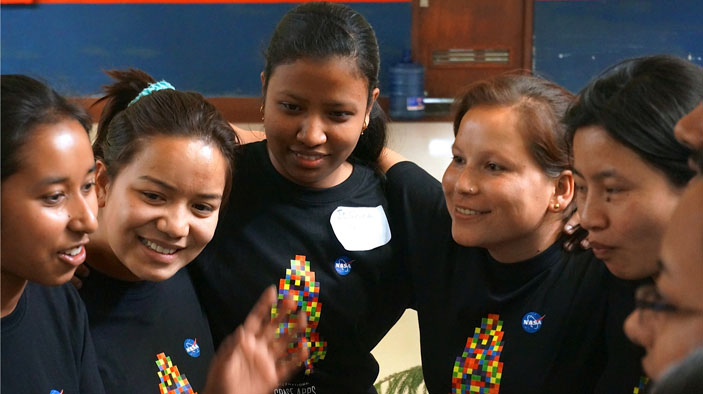Youthful Nepal Team Stars in NASA’s International Space Apps Challenge
April 26, 2013
In sheer numbers, the second NASA International Space Apps Challenge April 20-21 made a big splash. More than 9,000 people worldwide—four times as many as last year—dove into the 48-hour hackathon to confront questions of space exploration and social need, churning out some 600 potential solutions.
Nowhere was participation more intense than in Kathmandu, Nepal, where 60 software developers, engineers, designers, and technologists comprised 17 teams. Working side by side, they devised products including an all-terrain, GPS-guided, video-equipped rover for disaster response; and a way to more quickly detect potentially dangerous climate-change anomalies using data from space.
Not bad for a weekend’s work.

“It was amazing to see a group of young scientists who have the potential to put Nepal on the map by creating simple technologies that can change lives,” said Anja Rasmussen of the International Centre for Integrated Mountain Development (ICIMOD), which hosted the local participants under the SERVIR-Himalaya initiative. SERVIR is a satellite data and image platform created by NASA and the U.S. Agency for International Development (USAID).
The Kathmandu event organized locally by the YoungInnovations tech startup was part of a global Space Apps event that competed simultaneously on all seven continents, but it was the only event using information from the SERVIR program.
SERVIR and ICIMOD turn data from space into products that help governments and organizations make more informed decisions about managing environmental resources. SERVIR-Himalaya, for example, introduced a way to measure snow coverage and forecast snowmelt and runoff from mountain glaciers and snow pack into rivers below, which affects water availability and flooding potential in some of the world’s most populated regions.
DAI is helping NASA and USAID create awareness and demand for these products.

The 60 Space Apps participants in Kathmandu included 16 women, significant in Nepal’s male-dominated technology sector. Some teams called on virtual input from others around the globe as they worked on challenges such as mapping emergency service providers in Kathmandu through an online interface. The top three teams were announced at the closing ceremony and awarded cash prizes of NPR 30,000, 20,000, and 10,000, or $346, $230, and $115.
“Today is the world of information visualization,” said Rabindra Kharel, who, with partner Deerghayu Shrestha, developed a way to detect and visualize threatening anomalies in spatiotemporal climate data. “I would love to work in this field and extend my project to make it a real-time environment surveillance system.”
ICIMOD and YoungInnovations will submit the top two local solutions to NASA for global Space Apps judging and awards. Through the SERVIR-Himalaya Youth Initiative, ICIMOD is considering organizing similar events in other parts of the Hindu Kush Himalayan region, including in Afghanistan, Bangladesh, Bhutan, China, India, Myanmar, and Pakistan.
More information about this story is available here or via Twitter and Facebook or by contacting Stacy Whittle, Senior Lead for Communications on the SERVIR Demand Activity at stacy_whittle@dai.com.
RELATED CONTENT:
Documentary Describes How Project Delivers Clean Water for 1.8 Million Filipinos
A recently released 15-minute documentary describes how a DAI-led project in the Philippines made it possible for water providers to expand and upgrade their systems, and deliver water services to another 1.8 million people.
Read More